Author: Eric Source: Network reprint Hits: 5685 Update Time: 2006-1-9 15:33:54
How to send a satisfactory low frequency with a small single, I think the transmission design is the most ideal way. However, because the speaker structure is so complicated, few people try to make it. Here I introduce a design with an 8-inch woofer as the main body for DIY people to try, the effect is guaranteed to be amazing. The size chart is as follows (Figure 1 is the low speaker, Figure 2 is the middle and high speakers):
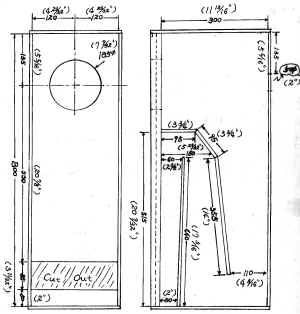
Figure 1
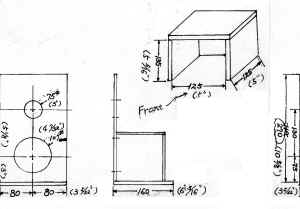
Figure II

The wood used is HDF (high pressure dense board), the general speaker box is MDF (medium pressure dense board), the front baffle is 2 pieces of 6 points HDF bonding, and the other is 6 points of HDF. This design separates the middle and high speakers from the low speakers for the sake of flexibility. Reason 1. The medium and high speakers are small in size and low in cost. If you like, you can do more than a few different types of monomers to enjoy different sounds. Reason 2. To get a good sound, the placement of the speakers is very important. The distance between the woofer and the rear wall and side wall directly changes the response of the low frequency. The middle and high frequency speakers will affect the depth and positioning of the sound field. Therefore, the middle and high speakers can be placed separately by the speaker frame to find the most suitable position of the low frequency and the middle and high frequency. (How to correctly position the speaker, I intend to do a detailed introduction in the next article to ensure more effective than changing equipment, please look forward to it.)
The speaker unit used is VIFA's product. Of course, you can choose a similar product replacement, such as
DYNAAUDIO, SEAS, SCAN-SPEAK, PEERLESS, etc. The monomers used are as follows:
The woofer uses an 8" long stroke unit and the VIFA number is M22WR0906.
The midrange unit uses a 5" cone monomer and the VIFA number is C13MG0908.
The tweeter monomer uses a 1" aluminum film monomer and the VIFA number is D25AG3506.
The above monomer data are shown in Figures 3, 4 and 5. I intend to use the electronic crossover method, so I first put the crossover network separately, so that it can be removed at any time. Inductance and capacitance in the crossover network are not easy to obtain. It is recommended that readers can go to Xining Electronic Plaza to find a good quality ready-made three-way crossover. By the way, buy some sound-absorbing cotton and speaker terminals. When making a speaker, remember to apply the white glue and then apply the nails to ensure that all the joints of the speakers are completely tight. Do not nail the back plate first, because you need to fill in the sound-absorbing cotton, and finally apply white glue and nail the back plate. The middle speaker also needs to be filled with sound-absorbing cotton. If the middle-sound monomer of the convex basin is used, this step can be omitted.
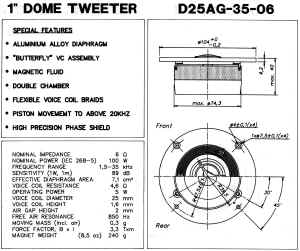
Figure III

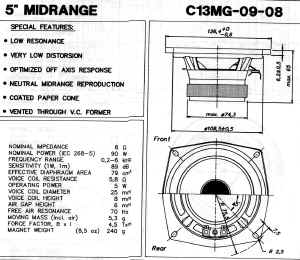
Figure 4
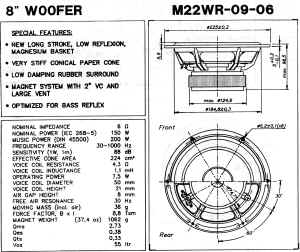
Figure 5

The holes of the horn and the terminal are preferably cut according to the physical size. If it is smaller, the trowel can be trimmed.
If you have any questions about the production, please write to us: E-mail ˉ
Supplementary note:
It is best to add spikes under the low speakers.
The color of the exterior veneer can be chosen according to your preference.
If you want to place the high-altitude speaker directly on the low-range speaker, please use a special fixing glue for the speaker like bubble gum, or pad a thick sponge.
If an off-the-shelf crossover network or a self-selected monomer is used, the resistance of the tweeter and the midrange unit may be adjusted by the efficiency of the individual cells.
Author: Eric Source: Network reprint Hits: 5685 Update Time: 2006-1-9 15:33:54
How to send a satisfactory low frequency with a small single, I think the transmission design is the most ideal way. However, because the speaker structure is so complicated, few people try to make it. Here I introduce a design with an 8-inch woofer as the main body for DIY people to try, the effect is guaranteed to be amazing. The size chart is as follows (Figure 1 is the low speaker, Figure 2 is the middle and high speakers):

Figure 1

Figure II

The wood used is HDF (high pressure dense board), the general speaker box is MDF (medium pressure dense board), the front baffle is 2 pieces of 6 points HDF bonding, and the other is 6 points of HDF. This design separates the middle and high speakers from the low speakers for the sake of flexibility. Reason 1. The medium and high speakers are small in size and low in cost. If you like, you can do more than a few different types of monomers to enjoy different sounds. Reason 2. To get a good sound, the placement of the speakers is very important. The distance between the woofer and the rear wall and side wall directly changes the response of the low frequency. The middle and high frequency speakers will affect the depth and positioning of the sound field. Therefore, the middle and high speakers can be placed separately by the speaker frame to find the most suitable position of the low frequency and the middle and high frequency. (How to correctly position the speaker, I intend to do a detailed introduction in the next article to ensure more effective than changing equipment, please look forward to it.)
The speaker unit used is VIFA's product. Of course, you can choose a similar product replacement, such as
DYNAAUDIO, SEAS, SCAN-SPEAK, PEERLESS, etc. The monomers used are as follows:
The woofer uses an 8" long stroke unit and the VIFA number is M22WR0906.
The midrange unit uses a 5" cone monomer and the VIFA number is C13MG0908.
The tweeter monomer uses a 1" aluminum film monomer and the VIFA number is D25AG3506.
The above monomer data are shown in Figures 3, 4 and 5. I intend to use the electronic crossover method, so I first put the crossover network separately, so that it can be removed at any time. Inductance and capacitance in the crossover network are not easy to obtain. It is recommended that readers can go to Xining Electronic Plaza to find a good quality ready-made three-way crossover. By the way, buy some sound-absorbing cotton and speaker terminals. When making a speaker, remember to apply the white glue and then apply the nails to ensure that all the joints of the speakers are completely tight. Do not nail the back plate first, because you need to fill in the sound-absorbing cotton, and finally apply white glue and nail the back plate. The middle speaker also needs to be filled with sound-absorbing cotton. If the middle-sound monomer of the convex basin is used, this step can be omitted.

Figure III


Figure 4

Figure 5

The holes of the horn and the terminal are preferably cut according to the physical size. If it is smaller, the trowel can be trimmed.
If you have any questions about the production, please write to us: E-mail ˉ
Supplementary note:
It is best to add spikes under the low speakers.
The color of the exterior veneer can be chosen according to your preference.
If you want to place the high-altitude speaker directly on the low-range speaker, please use a special fixing glue for the speaker like bubble gum, or pad a thick sponge.
If an off-the-shelf crossover network or a self-selected monomer is used, the resistance of the tweeter and the midrange unit may be adjusted by the efficiency of the individual cells.
Author: Eric Source: Network reprint Hits: 5685 Update Time: 2006-1-9 15:33:54
How to send a satisfactory low frequency with a small single, I think the transmission design is the most ideal way. However, because the speaker structure is so complicated, few people try to make it. Here I introduce a design with an 8-inch woofer as the main body for DIY people to try, the effect is guaranteed to be amazing. The size chart is as follows (Figure 1 is the low speaker, Figure 2 is the middle and high speakers):

Figure 1

Figure II

The wood used is HDF (high pressure dense board), the general speaker box is MDF (medium pressure dense board), the front baffle is 2 pieces of 6 points HDF bonding, and the other is 6 points of HDF. This design separates the middle and high speakers from the low speakers for the sake of flexibility. Reason 1. The medium and high speakers are small in size and low in cost. If you like, you can do more than a few different types of monomers to enjoy different sounds. Reason 2. To get a good sound, the placement of the speakers is very important. The distance between the woofer and the rear wall and side wall directly changes the response of the low frequency. The middle and high frequency speakers will affect the depth and positioning of the sound field. Therefore, the middle and high speakers can be placed separately by the speaker frame to find the most suitable position of the low frequency and the middle and high frequency. (How to correctly position the speaker, I intend to do a detailed introduction in the next article to ensure more effective than changing equipment, please look forward to it.)
The speaker unit used is VIFA's product. Of course, you can choose a similar product replacement, such as
DYNAAUDIO, SEAS, SCAN-SPEAK, PEERLESS, etc. The monomers used are as follows:
The woofer uses an 8" long stroke unit and the VIFA number is M22WR0906.
The midrange unit uses a 5" cone monomer and the VIFA number is C13MG0908.
The tweeter monomer uses a 1" aluminum film monomer and the VIFA number is D25AG3506.
The above monomer data are shown in Figures 3, 4 and 5. I intend to use the electronic crossover method, so I first put the crossover network separately, so that it can be removed at any time. Inductance and capacitance in the crossover network are not easy to obtain. It is recommended that readers can go to Xining Electronic Plaza to find a good quality ready-made three-way crossover. By the way, buy some sound-absorbing cotton and speaker terminals. When making a speaker, remember to apply the white glue and then apply the nails to ensure that all the joints of the speakers are completely tight. Do not nail the back plate first, because you need to fill in the sound-absorbing cotton, and finally apply white glue and nail the back plate. The middle speaker also needs to be filled with sound-absorbing cotton. If the middle-sound monomer of the convex basin is used, this step can be omitted.

Figure III


Figure 4

Figure 5

The holes of the horn and the terminal are preferably cut according to the physical size. If it is smaller, the trowel can be trimmed.
If you have any questions about the production, please write to us: E-mail ˉ
Supplementary note:
It is best to add spikes under the low speakers.
The color of the exterior veneer can be chosen according to your preference.
If you want to place the high-altitude speaker directly on the low-range speaker, please use a special fixing glue for the speaker like bubble gum, or pad a thick sponge.
If an off-the-shelf crossover network or a self-selected monomer is used, the resistance of the tweeter and the midrange unit may be adjusted by the efficiency of the individual cells.
Outdoor Waterproof LED Curtain
Led Curtain/Led Mesh, Outdoor Led Display,Indoor Led Display,Light Box
Rental LED Display,Fixed LED Display Co., Ltd. , http://www.nbleddisplay.com